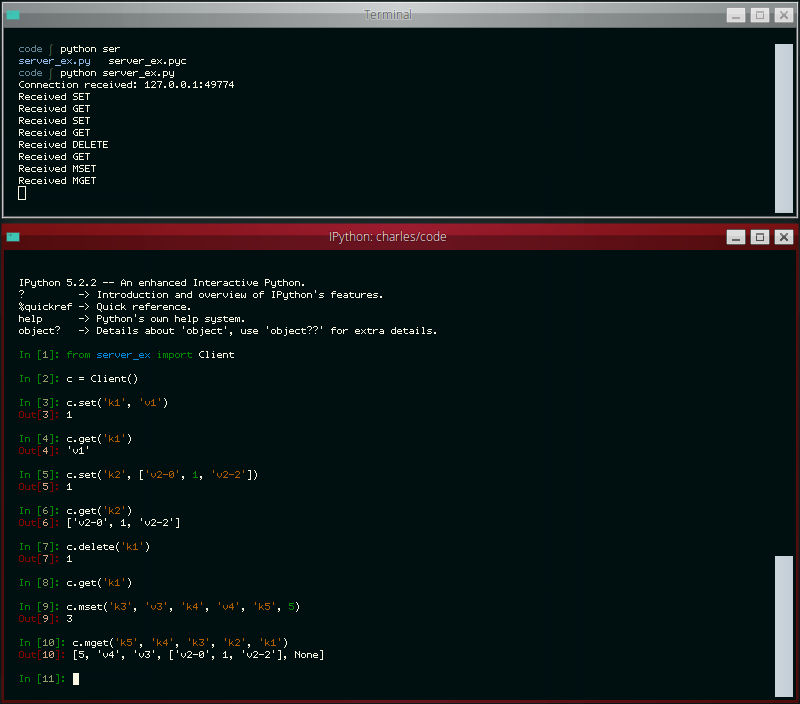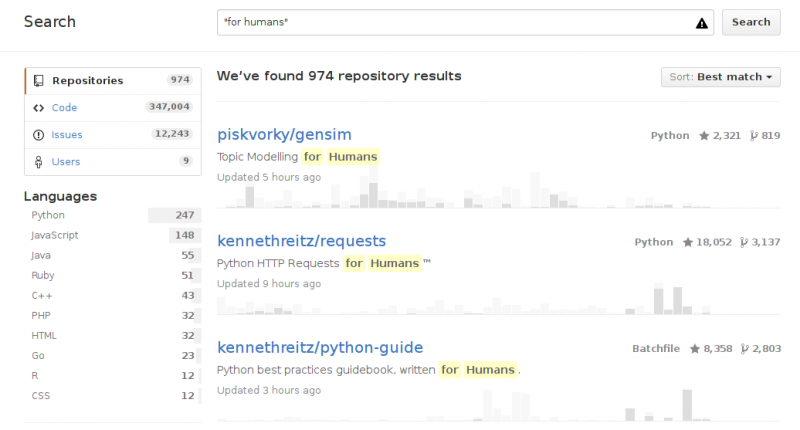Search: "User"
Kyoto Tycoon in 2019
I've been interested in using Kyoto Tycoon for some time. Kyoto Tycoon, successor to Tokyo Tyrant, is a key/value database with a number of desirable features:
- On-disk hash table for fast random access
- On-disk b-tree for ordered collections
- Server supports thousands of concurrent connections
- Embedded lua scripting
- Asynchronous replication, hot backups, update logging
- Exceptional performance
Using SQLite Full-Text Search with Python
In this post I will show how to use SQLite full-text search with Python (and a lot of help from peewee ORM). We will see how to index content for searching, and how to order search results using two ranking algorithms.
Last week I migrated my site from Postgresql to SQLite. I had been using Redis to power my site's search, but since SQLite has an awesome full-text search extension, I decided to give it a try. I am really pleased with the results, and being able to specify boolean search queries is an added plus. Here is a brief overview of the types of search queries SQLite supports:
- Simple phrase: peewee would return all docs containing the word peewee.
- Prefix queries: py* would return docs containing Python, pypi, etc.
- Quoted phrases: "sqlite extension"
NEAR: peewee NEAR sqlite would return docs containing the words peewee and sqlite with no more than10intervening words. You can also specify the max number of intervening words, e.g. peewee NEAR/3 sqlite.AND,OR,NOT: sqlite OR postgresql AND NOT mysql would return docs about high-quality databases (just trollin).
Check out the full post for details on adding full-text search to your project.
SQLite Table-Valued Functions with Python
One of the benefits of running an embedded database like SQLite is that you can configure SQLite to call into your application's code. SQLite provides APIs that allow you to create your own scalar functions, aggregate functions, collations, and even your own virtual tables. In this post I'll describe how I used the virtual table APIs to expose a nice API for creating table-valued (or, multi-value) functions in Python. The project is called sqlite-vtfunc and is hosted on GitHub. If you use Peewee, an equivalent implementation is included in the Peewee SQLite extensions.
A Stroll Down Memory Lane: Scripting AOL
When I started working at my current job I was surprised to see that everyone used IRC as their primary means of communication - much more so than email or IM. I recently wrote a small irc bot library in python - it was a ton of fun and reminded me of some of the first programs I wrote that were bots and scripts for America Online.
Using the SQLite JSON1 and FTS5 Extensions with Python
Back in September, word started getting around trendy programming circles about a new file that had appeared in the SQLite fossil repo named json1.c. I originally wrote up a post that contained some gross hacks in order to get pysqlite to compile and work with the new json1 extension. With the release of SQLite 3.9.0, those hacks are no longer necessary.
SQLite 3.9.0 is a fantastic release. In addition to the much anticipated json1 extension, there is a new version of the full-text search extension called fts5. fts5 improves performance of complex search queries and provides an out-of-the-box BM25 ranking implementation. You can also boost the significance of particular fields in the ranking. I suggest you check out the release notes for the full list of enhancements
This post will describe how to compile SQLite with support for json1 and fts5. We'll use the new SQLite library to compile a python driver so we can use the new features from python. Because I really like pysqlite and apsw, I've included instructions for building both of them. Finally, we'll use peewee ORM to run queries using the json1 and fts5 extensions.
Extending SQLite with Python
SQLite is an embedded database, which means that instead of running as a separate server process, the actual database engine resides within the application. This makes it possible for the database to call directly into the application when it would be beneficial to add some low-level, application-specific functionality. SQLite provides numerous hooks for inserting user code and callbacks, and, through virtual tables, it is even possible to construct a completely user-defined table. By extending the SQL language with Python, it is often possible to express things more elegantly than if we were to perform calculations after the fact.
In this post I'll describe how to extend SQLite with Python, adding functions and aggregates that will be callable directly from any SQL queries you execute. We'll wrap up by looking at SQLite's virtual table mechanism and seeing how to expose a SQL interface over external data sources.
Write your own miniature Redis with Python
The other day the idea occurred to me that it would be neat to write a simple Redis-like database server. While I've had plenty of experience with WSGI applications, a database server presented a novel challenge and proved to be a nice practical way of learning how to work with sockets in Python. In this post I'll share what I learned along the way.
The goal of my project was to write a simple server that I could use with a task queue project of mine called huey. Huey uses Redis as the default storage engine for tracking enqueued jobs, results of finished jobs, and other things. For the purposes of this post, I've reduced the scope of the original project even further so as not to muddy the waters with code you could very easily write yourself, but if you're curious, you can check out the end result here (documentation).
The server we'll be building will be able to respond to the following commands:
- GET
<key> - SET
<key><value> - DELETE
<key> - FLUSH
- MGET
<key1>...<keyn> - MSET
<key1><value1>...<keyn><valuen>
We'll support the following data-types as well:
- Strings and Binary Data
- Numbers
- NULL
- Arrays (which may be nested)
- Dictionaries (which may be nested)
- Error messages
"For Humans" makes me cringe
When Kenneth Reitz created the requests library, the Python community rushed to embrace the project, as it provided (finally) a clean, sane API for making HTTP requests. He subtitled his project "Python HTTP Requests for Humans", referring, I suppose, to the fact that his API provided developer-friendly APIs. If naming things "for humans" had stopped there, that would have been fine with me, but instead there's been a steady stream of new projects describing themselves as being "For Humans" and I have issues with that.
Shortcomings in the Django ORM and a look at Peewee, a lightweight alternative
In this post I'd like to talk about some of the shortcomings of the Django ORM, the ways peewee approaches things differently, and how this resulted in peewee having an API that is both more consistent and more expressive.
New features planned for Python 4.0
With the release of Python 3.8 coming soon, the core development team has asked me to summarize our latest discussions on the new features planned for Python 4.0, codename "ouroboros: the snake will eat itself". This will be an exciting release and a significant milestone, many thanks to the hard work of over 100 contributors.





